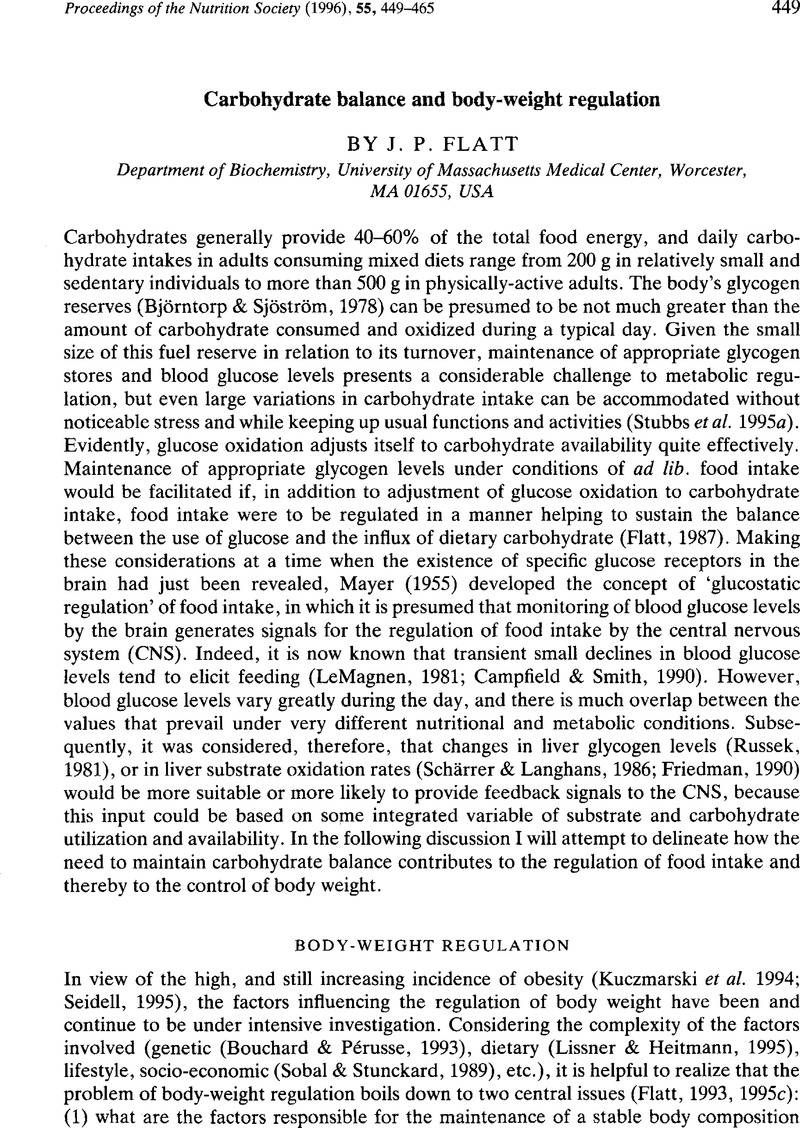Crossref Citations
This article has been cited by the following publications. This list is generated based on data provided by Crossref.
ASTRUP, ARNE
RABEN, ANNE
BUEMANN, BENJAMIN
and
TOUBRO, SØREN
1997.
Fat Metabolism in the Predisposition to Obesitya.
Annals of the New York Academy of Sciences,
Vol. 827,
Issue. 1,
p.
417.
Flatt, J. P.
1997.
How NOT to Approach the Obesity Problem.
Obesity Research,
Vol. 5,
Issue. 6,
p.
632.
Flatt, J.P.
1998.
What Do We Most Need to Learn about Food Intake Regulation?.
Obesity Research,
Vol. 6,
Issue. 4,
p.
307.
Flatt, J
1999.
Neural and Metabolic Control of Macronutrient Intake.
Melanson, Kathleen J.
Westerterp-Plantenga, Margriet S.
Campfield, L. Arthur
and
Saris, Wim H. M.
1999.
Appetite and blood glucose profiles in humans after glycogen-depleting exercise.
Journal of Applied Physiology,
Vol. 87,
Issue. 3,
p.
947.
Melanson, Kathleen J.
Westerterp-Plantenga, Margriet S.
Arthur Campfield, L.
and
Saris, Wim H. M.
1999.
Blood glucose and meal patterns in time-blinded males, after aspartame, carbohydrate, and fat consumption, in relation to sweetness perception.
British Journal of Nutrition,
Vol. 82,
Issue. 6,
p.
437.
Martinez, J. Alfredo
2000.
Body-weight regulation: causes of obesity.
Proceedings of the Nutrition Society,
Vol. 59,
Issue. 3,
p.
337.
Kovacs, Eva M. R.
Westerterp-Plantenga, Margriet S.
Saris, Wim H. M.
Melanson, Kathleen J.
Goossens, Ine
Geurten, Peter
and
Brouns, Fred
2002.
Associations between spontaneous meal initiations and blood glucose dynamics in overweight men in negative energy balance.
British Journal of Nutrition,
Vol. 87,
Issue. 1,
p.
39.
Papakonstantinou, Emilia
Flatt, William P.
Huth, Peter J.
and
Harris, Ruth B.S.
2003.
High Dietary Calcium Reduces Body Fat Content, Digestibility of Fat, and Serum Vitamin D in Rats.
Obesity Research,
Vol. 11,
Issue. 3,
p.
387.
Yang, Ruojing
and
Newgard, Christopher B.
2003.
Hepatic Expression of a Targeting Subunit of Protein Phosphatase-1 in Streptozotocin-diabetic Rats Reverses Hyperglycemia and Hyperphagia Despite Depressed Glucokinase Expression.
Journal of Biological Chemistry,
Vol. 278,
Issue. 26,
p.
23418.
Basdevant, Arnaud
2003.
Histoire naturelle des obésités.
Bulletin de l'Académie Nationale de Médecine,
Vol. 187,
Issue. 7,
p.
1343.
Basdevant, A.
2004.
Histoire naturelle des obésités.
Annales Pharmaceutiques Françaises,
Vol. 62,
Issue. 2,
p.
80.
Melanson, Kathleen J.
2004.
Food Intake Regulation in Body Weight Management.
Nutrition Today,
Vol. 39,
Issue. 5,
p.
203.
Hensrud, Donald D.
2004.
Diet and obesity.
Current Opinion in Gastroenterology,
Vol. 20,
Issue. 2,
p.
119.
Hermansen, Kjeld
and
Raben, Anne
2006.
Carbohydrates in Food, Second Edition.
p.
89.
Eckel, Robert H
Hernandez, Teri L
Bell, Melanie L
Weil, Kathleen M
Shepard, Trudy Y
Grunwald, Gary K
Sharp, Teresa A
Francis, Coni C
and
Hill, James O
2006.
Carbohydrate balance predicts weight and fat gain in adults.
The American Journal of Clinical Nutrition,
Vol. 83,
Issue. 4,
p.
803.
Newby, P. K.
2007.
Are Dietary Intakes and Eating Behaviors Related to Childhood Obesity? A Comprehensive Review of the Evidence.
Journal of Law, Medicine & Ethics,
Vol. 35,
Issue. 1,
p.
35.
van Can, Judith G. P.
IJzerman, T. Herman
van Loon, Luc J. C.
Brouns, Fred
and
Blaak, Ellen E.
2009.
Reduced glycaemic and insulinaemic responses following isomaltulose ingestion: implications for postprandial substrate use.
British Journal of Nutrition,
Vol. 102,
Issue. 10,
p.
1408.
van Can, Judith G. P.
IJzerman, T. Herman
van Loon, Luc J. C.
Brouns, Fred
and
Blaak, Ellen E.
2009.
Reduced glycaemic and insulinaemic responses following trehalose ingestion: implications for postprandial substrate use.
British Journal of Nutrition,
Vol. 102,
Issue. 10,
p.
1395.
Gower, Barbara A.
Hunter, Gary R.
Chandler‐Laney, Paula C.
Alvarez, Jessica A.
and
Bush, Nikki C.
2010.
Glucose Metabolism and Diet Predict Changes in Adiposity and Fat Distribution in Weight‐reduced Women.
Obesity,
Vol. 18,
Issue. 8,
p.
1532.





